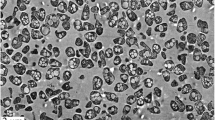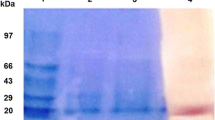Abstract
WhenPseudomonas oleovorans (GPo1) is grown on sodium octanoate under ammonium limiting conditions, it is able to accumulate a copolyester consisting of medium chain length 3-hydroxyalkanoic acids (PHAm). 3-Hydroxybutyrate is only incorporated in trace amounts. WhenP. oleovorans is equipped with the PHB biosynthetic genes ofAlcaligenes eutrophus (GPo1[pVK101::PP1]), it forms a polyester containing major amounts of 3-hydroxybutyrate. The resulting polymer however is a blend of PHAm and PHB, rather than a copolymer of 3-hydroxybutyrate and medium chain length 3-hydroxyalkanoic acids [11]. To establish whether PHAm and PHB molecules are stored in the same or separate granules by this recombinantP. oleovorans strain, we studied polymer forming cells by freeze-fracture electron microscopy. This approach is possible because previous freeze-fracture electron microscopy studies on PHAm and PHB accumulating strains have shown that PHAm and PHB granules can be distinguished from each other: PHAm granules from mushroom-like structures, whereas PHB granules from needle structures during freeze-fracturing. In this paper we show that stationary phase cells of GPo1[pVK101::PP1] contained both mushroom and needle-like structures, indicating that PHAm and PHB chains were stored in separate granules. To be able to determine whether the separation of PHAm and PHB is complete, the respective granules were separated on sucrose gradients. A total cell extract of GPo1[pVK101::PP1] which was subjected to sucrose gradient centrifugation revealed two white bands of different densities: the upper band with a density of 1.05 g/mL consisted exclusively of PHAm granules, while the lower band with a density of 1.19 g/mL consisted of PHB granules only. Thus, when bacteria synthesize both PHAm and PHB, the resulting polymer chains are segregated completely and stored in separate granules.
Similar content being viewed by others
References
R. H. Findley and D. C. White (1983)Appl. Environ. Microbiol. 45 71–78.
L. L. Wallen and W. K. Rohwedder (1984)Environ. Sci. Technol. 8 576–579.
M. Lemoigne (1926)Bull. Soc. Chim. Biol. 8 770–782.
M. J. de Smet, G. Eggink, B. Witholt, J. Kingma, and H. Wijnberg (1983)J. Bacteriol. 154 870–878.
R. G. Lageveen, G. W. Huisman, H. Preusting, P. Ketelaar, G. Eggink, and B. Witholt (1988)Appl. Environ. Microbiol. 54 2924–2932.
H. Brandl, R. A. Gross, R. W. Lenz, and R. Clinton Fuller (1988)Appl. Environ. Microbiol. 54 1977–1982.
G. W. Huisman, O. de Leeuw, G. Eggink, and B. Witholt (1989)Appl. Environ. Microbiol. 55 1949–1954.
G. W. Haywood, A. J. Anderson, and E. A. Dawes (1989)Biotechnol. Lett. 11 471–476.
R. A. Gross, C. De Mello, R. W. Lenz, H. Brandl, and R. C. Fuller (1989)Macromolecules 22 1106–1115.
H. Preusting, A. Nijenhuis, and B. Witholt (1990)Macromolecules 23 4220–4224.
A. Timm, D. Byrom, and A. Steinbüchel (1990)Appl. Microbiol. Biotechnol. 33 296–301.
W. F. Dunlop and A. W. Robarts (1973)J. Bacteriol. 114 1271–1280.
H. Preusting, J. Kingma, and B. Witholt (1991)Enzyme Microb. Technol. 13 770–780.
R. D. Schwartz and C. J. McCoy (1973)Appl. Microbiol. 26 217–218.
G. W. Huisman, E. Wonink, R. Meima, B. Kazemier, P. Terpstra, and B. Witholt (1991)J. Biol. Chem. 266 2191–2198.
G. Ditta, S. Stanfield, D. Corbin, and D. R. Helinski (1980)Proc. Natl. Acad. Sci. U.S.A. 77 7347–7351.
P. Schubert, A. Steinbüchel, and H. G. Schlegel (1988)J. Bacteriol. 170 5837–5847.
B. Witholt (1972)J. Bacteriol. 109 350–364.
B. Witholt, M. Boekhout, M. Brock, J. Kingma, H. van Heerikhuizen, and L. de Leij (1976)Anal. Biochem. 74 160–170.
R. Guerrero, J. Mas, and C. Pedrós-Alió (1984)Arch. Microbiol. 137 350–356.
C. Pedrós-Alió, J. Mas, and R. Guerrero (1985)Arch. Microbiol. 143 178–184.
G. N. Barnard and J. K. M. Sanders (1989)J. Biol. Chem. 264 3286–3291.
G. J. M. de Koning and P. J. Lemstra (1992)Polym. Commun. (accepted for publication).
K. W. Nickerson (1982)Appl. Environ. Microbiol. 43 1208–1209.
P. J. Barham, A. Keller, E. L. Otun, and P. A. Holmes (1984)J. Mater. Sci. 19 2781–2794.
Y. B. Kim, R. W. Lenz, and R. C. Fuller (1991)Macromolecules 24 5256–5260.
Author information
Authors and Affiliations
Rights and permissions
About this article
Cite this article
Preusting, H., Kingma, J., Huisman, G. et al. Formation of polyester blends by a recombinant strain ofPseudomonas oleovorans: Different poly(3-hydroxyalkanoates) are stored in separate granules. J Environ Polym Degr 1, 11–21 (1993). https://doi.org/10.1007/BF01457649
Issue Date:
DOI: https://doi.org/10.1007/BF01457649




